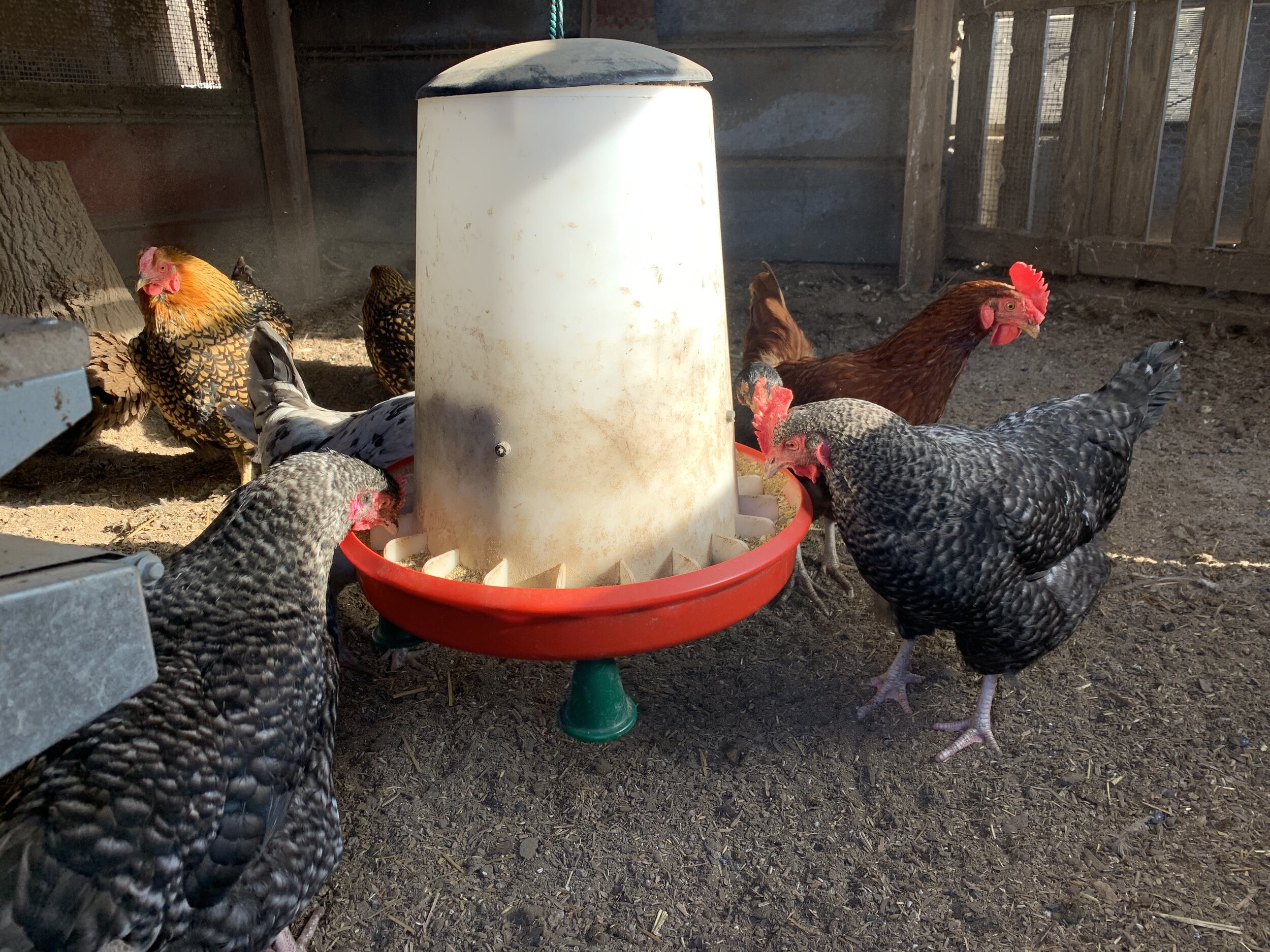Picky Chickens?
Wherein I discuss some ways to help your chickens understand that chicken feed ain’t free and why they should eat what they’re given…or else.
Wasted feed is no joke. I’ve experienced it. My hens picking through their feed to get to the “good stuff” first and getting the rest of it all over the place. Their “good stuff” is the tastiest and easiest to get to and is not what I’d consider “good stuff”. Besides the cost of feed and the time you put into it, the ladies may not be getting all of their nutritional needs met.
If you feed pellets to your hens you may not feel this message. Pellets are handy and they have all the necessary nutrients. But they are processed and often have added fillers, so I feed only whole mash style to my hens, specifically the “Classic Grind” from New Country Organics. It looks more like food I might eat (I have not tried it though). Look at the label and you’ll see all-natural, organic ingredients and no soy. It also has a pleasant odor.
Even though I haven’t eaten, nor bathed in it or in any other way digested it, I love this chicken feed. (
Full disclosure, I sell New Country brand feeds - see the Shop button above).
Despite me sounding like a commercial, (can you imagine the bathing-in-chicken-feed commercial? yeah!), it’s important to know my feed source because my chicken’s behavior is specific to that brand and style of feed.
Whole grain mash feed is the only style that makes an effort to mimic nature. It isn’t crushed up and regurgitated by specialized machinery to make it into pellets or crumbles. Pellets and crumbles go through added processes that blend and combine everything into a neat little package. Additionally they often have added binders and preservatives included. It’s all just a lot of unnecessary, additional energy and ingredients to make a feed that’s not even necessarily better for your chickens. With a mash or whole grain feed you know what you’re getting, it’s preferred by your flock (try two different types side by side sometime and see what they go crazy for - at least in my experience), and it’s less processed and less energy intensive.
The downside of mash style feed is the tendency of the flock to pick through it. Powdered ingredients like alfalfa, kelp and any vitamins and minerals necessary, often come in a powdered form and are essential for the health of a flock. Chickens can and will pick through feed to get to the grains and seeds they want and they don’t care where all the other stuff - often the powder - ends up. If you are limited by the expanse of your backyard, however big that may be, and feeding your birds out on the free range isn’t an option, then finding the best option to feed them, an option that meets all of their natural needs, can give them just what they need.
My chickens mostly don’t do much billing out because, I believe, somehow I have “trained” them and, besides the pelleted feed option, I’ve learned of a few other ways to get all the necessary goodness into your hens so they get all of the benefits of a whole mash ration.
On with the tips! Hopefully these will help you save money and keep your flock healthy!
Raise the feeder. Typical gravity feeders like I use should be at a chicken’s shoulder height. They shouldn’t have to get on their tiptoes or crane their necks to eat but they should just be able to comfortably get their heads in.
Get a divider for your feeder so that your chickens can’t bill out their feed as easily.
Get an enclosed type or “no-waste” feeder. Open feeders like gravity-fed or bowl feeders are more likely to get picked through. Enclosed feeders, into which a hen has to stick her head, will eliminate picking through since what they pick through remains in the feeder. There are a lot of DIY solutions for this type of feeder using PVC, Buckets, or even plastic storage bins.
The Wise Mountable feeder at right is available in the Shop
Wet down the feed. This shouldn’t be done for large quantities as the feed could get moldy and rancid. Rather, this can be done with small quantities on a daily basis. Take any powder left in the feeder, pour it in a bowl, add some water, and feed the chickens separately. It is best not to get your feeder wet. A bit of warm, wet feed in the winter can be a nice treat for your girls. They’ll get more water intake and they’ll have a much harder time wasting feed.
Ferment the feed. Along the same lines as wetting down the feed but with a longer wait time. Many high quality, organic feeds can be successfully fermented which will utilize all of the ingredients and provided many other benefits. I’ll have a future post on fermentation but there is good guidance here.
Feed on a schedule. Instead of free choice feeding, you could try giving your hens just enough to eat all at once twice a day. This option takes more of your time and will require a little bit of trial and error but it could possibly save on your feed costs. How much does a chicken eat in a day? It all depends on the age and breed of your chickens as well as the time of year. A place to start would be about a 1/4 lb — or about 4 cups — a day. So half that if you’re feeding them 2x a day. See how much they eat and how long it takes them to finish it off and go from there.
Hopefully you’ll find something useful here and maybe save some money on feed costs. More next time! If you have any other tips for saving your feed from the chicken pickers, let us know in the comments!
Let the feeder go empty for a day. They’ll cluck at you but if any feed is left on the ground, the chickens will find it and eat it. If there is powder left in the feeder, they will eat it. Chickens love to eat and will eventually finish off whatever is left. My flock has figured out that they need to clean out their feeder before I fill it again. I don’t typically go more than a day without providing them more feed unless they have access to the garden where they can find additional supplements.
Hopefully you’ll find something useful here and maybe save some money on feed costs. More next time! If you have any other tips for saving your feed from the chicken pickers, let us know in the comments!
~O~








